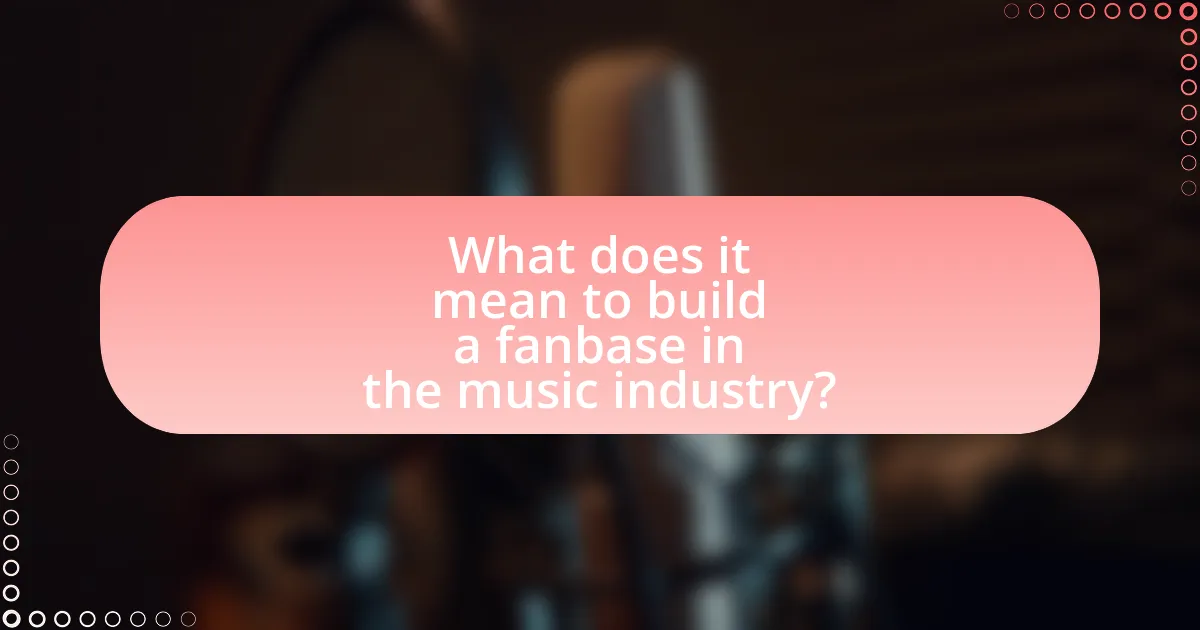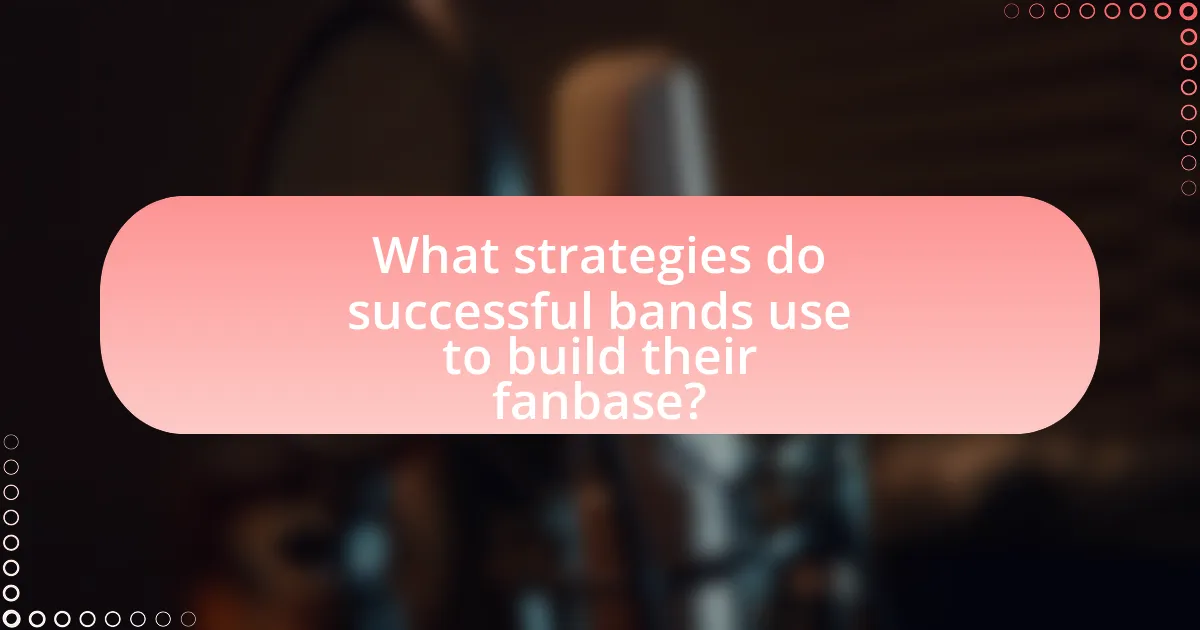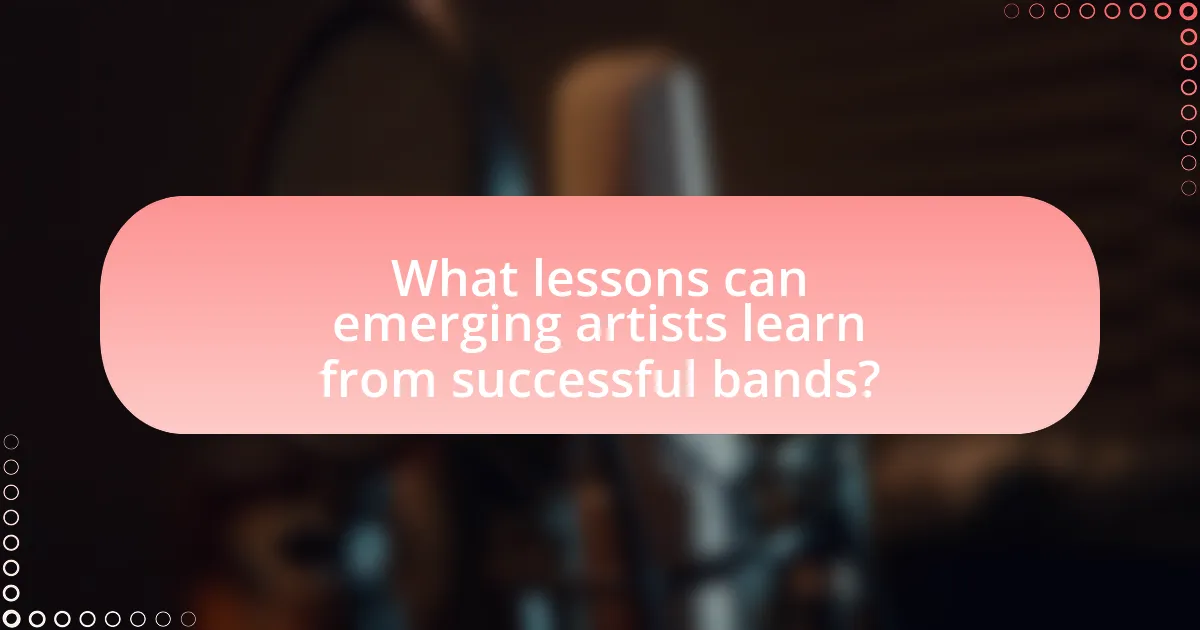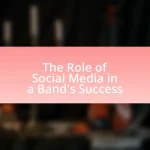Building a fanbase is essential for success in the music industry, as it involves cultivating a dedicated group of listeners who actively support an artist’s work. This article explores the strategies successful bands use to engage with their audience, including social media interaction, live performances, and data-driven marketing approaches. It highlights the characteristics that distinguish dedicated fans from casual listeners, the influence of demographics on fanbase formation, and the financial benefits of a loyal following. Additionally, the article provides practical tips for emerging artists on how to effectively identify and connect with their ideal audience while avoiding common pitfalls in fan engagement.

What does it mean to build a fanbase in the music industry?
Building a fanbase in the music industry means cultivating a dedicated group of listeners who actively support an artist’s work. This process involves engaging with fans through social media, live performances, and personal interactions, which fosters loyalty and encourages word-of-mouth promotion. Successful artists often leverage platforms like Spotify and Instagram to connect with their audience, resulting in increased visibility and sales. For instance, according to a 2020 report by the International Federation of the Phonographic Industry, artists with strong fan engagement see a 30% increase in streaming numbers compared to those with less interaction.
How do successful bands define their fanbase?
Successful bands define their fanbase by identifying the demographics, interests, and behaviors of their listeners. They analyze data from social media interactions, concert attendance, and streaming statistics to understand who their fans are and what they value. For instance, bands often use tools like Spotify for Artists and social media analytics to gather insights on age, location, and listening habits, allowing them to tailor their marketing strategies and engage more effectively with their audience. This data-driven approach helps bands create targeted content and experiences that resonate with their fanbase, ultimately fostering loyalty and community.
What characteristics distinguish a dedicated fanbase from casual listeners?
A dedicated fanbase is characterized by deep emotional investment and active engagement, while casual listeners typically exhibit superficial interest. Dedicated fans often participate in community activities, attend live events, and engage on social media platforms, demonstrating loyalty through consistent support and interaction. In contrast, casual listeners may enjoy the music but lack the commitment to follow the artist closely or participate in fan activities. Research indicates that dedicated fans are more likely to purchase merchandise and share content, contributing to the artist’s visibility and success, whereas casual listeners primarily consume music without further involvement.
How do demographics influence the formation of a fanbase?
Demographics significantly influence the formation of a fanbase by determining the characteristics and preferences of potential fans. Factors such as age, gender, income, education, and geographic location shape the types of music, marketing strategies, and engagement methods that resonate with different groups. For instance, a study by the Pew Research Center found that younger audiences are more likely to engage with pop and hip-hop genres, while older demographics tend to prefer classic rock and country music. This demographic insight allows bands to tailor their content and outreach efforts effectively, ensuring they connect with the right audience segments. Additionally, understanding demographic trends helps in identifying potential markets for tours and merchandise, ultimately enhancing fan engagement and loyalty.
Why is building a fanbase crucial for a band’s success?
Building a fanbase is crucial for a band’s success because it directly influences revenue, visibility, and longevity in the music industry. A strong fanbase provides consistent income through ticket sales, merchandise, and streaming, which are essential for sustaining a band’s operations. For instance, according to a 2020 report by the Music Industry Association, 70% of musicians’ income comes from live performances, underscoring the importance of having a dedicated audience to fill venues. Additionally, a loyal fanbase enhances a band’s visibility through word-of-mouth promotion and social media engagement, which can lead to increased opportunities for collaborations and media exposure. This interconnectedness between fan engagement and financial stability illustrates why building a fanbase is foundational for a band’s enduring success.
What role does a fanbase play in a band’s longevity?
A fanbase is crucial for a band’s longevity as it provides consistent support, engagement, and financial backing. Bands with a dedicated fanbase can rely on ticket sales, merchandise purchases, and streaming, which are essential for sustaining their careers. For instance, studies show that artists with strong fan engagement experience longer careers and higher revenue, as seen with bands like U2 and Coldplay, whose loyal followers contribute significantly to their ongoing success through concert attendance and merchandise sales. This financial and emotional support enables bands to continue producing music and touring, thereby extending their presence in the industry.
How does a strong fanbase impact a band’s revenue streams?
A strong fanbase significantly enhances a band’s revenue streams by increasing sales from merchandise, ticket sales, and streaming. When a band has a dedicated following, fans are more likely to purchase concert tickets, leading to higher attendance and greater revenue from live performances. For instance, according to a 2020 report by the Music Industry Association, artists with a loyal fanbase can see ticket sales increase by up to 50% compared to those with a less engaged audience. Additionally, a strong fanbase drives merchandise sales, as fans often buy branded items to show their support, contributing to overall income. Furthermore, engaged fans are more likely to stream and purchase music, which directly impacts a band’s earnings from digital platforms. Thus, the presence of a strong fanbase is crucial for maximizing a band’s financial success across multiple revenue channels.

What strategies do successful bands use to build their fanbase?
Successful bands build their fanbase through a combination of social media engagement, live performances, and strategic collaborations. Social media platforms like Instagram and TikTok allow bands to connect directly with fans, share behind-the-scenes content, and promote new music, which has been shown to increase fan engagement significantly. For instance, a study by the University of Southern California found that artists who actively engage with fans on social media see a 30% increase in concert attendance.
Additionally, live performances create memorable experiences that foster loyalty among fans. Bands that tour frequently and perform at various venues can reach new audiences and solidify their presence in the music scene. According to Pollstar, top-grossing tours can generate millions in revenue, indicating the importance of live shows in building a dedicated fanbase.
Collaborations with other artists also play a crucial role in expanding reach. By partnering with established musicians, bands can tap into new audiences and gain credibility. For example, when a lesser-known band collaborates with a popular artist, they often experience a surge in followers and streams, as evidenced by the success of collaborations highlighted in Billboard’s annual charts.
How do bands leverage social media to connect with fans?
Bands leverage social media to connect with fans by actively engaging them through regular updates, interactive content, and personalized communication. This engagement includes sharing behind-the-scenes content, hosting live Q&A sessions, and responding to fan comments, which fosters a sense of community and loyalty. For instance, a study by the Pew Research Center found that 69% of adults in the U.S. use social media, making it a vital platform for bands to reach and interact with their audience effectively. Additionally, platforms like Instagram and Twitter allow bands to showcase their personalities and music, enhancing fan relationships and driving ticket sales and merchandise purchases.
What platforms are most effective for engaging with fans?
Social media platforms such as Instagram, Twitter, and TikTok are most effective for engaging with fans. These platforms allow artists to share content, interact directly with followers, and create a sense of community. For instance, Instagram’s visual nature enables musicians to showcase their work and personal moments, while Twitter facilitates real-time communication and updates. TikTok’s algorithm promotes viral content, allowing artists to reach wider audiences quickly. According to a 2021 report by the Pew Research Center, 69% of adults in the U.S. use social media, highlighting its significance in fan engagement strategies.
How can bands create compelling content that resonates with their audience?
Bands can create compelling content that resonates with their audience by understanding their fans’ preferences and engaging them through authentic storytelling. Research indicates that 70% of consumers prefer brands that demonstrate authenticity, which highlights the importance of genuine connections in content creation. By sharing personal experiences, behind-the-scenes insights, and relatable themes, bands can foster a deeper emotional connection with their audience. Additionally, utilizing social media platforms effectively allows bands to interact directly with fans, gather feedback, and tailor content to meet their interests, further enhancing engagement and loyalty.
What role does live performance play in fanbase development?
Live performance is crucial in fanbase development as it creates direct, personal connections between artists and their audience. These events allow fans to experience the music in an immersive environment, fostering emotional engagement and loyalty. According to a study by the National Endowment for the Arts, live music events significantly enhance community engagement and can lead to increased fan retention, as 70% of attendees report feeling a stronger connection to artists after attending a concert. This connection often translates into increased merchandise sales, social media following, and word-of-mouth promotion, all of which are vital for expanding a fanbase.
How can bands enhance the concert experience to attract more fans?
Bands can enhance the concert experience to attract more fans by incorporating interactive elements, high-quality production, and engaging setlists. Interactive elements, such as fan participation through sing-alongs or social media integration, create a sense of community and involvement, which can lead to increased fan loyalty. High-quality production, including impressive lighting, sound, and stage design, elevates the overall experience, making it memorable and shareable on social media platforms. Engaging setlists that include a mix of popular hits and new material keep the audience excited and invested in the performance. According to a study by Eventbrite, 78% of concertgoers are more likely to attend a show if they know it will be an immersive experience, highlighting the importance of these enhancements in attracting and retaining fans.
What are the benefits of touring for building a fanbase?
Touring significantly enhances fanbase growth by providing direct engagement opportunities between artists and their audience. Live performances create memorable experiences that foster emotional connections, leading to increased loyalty and word-of-mouth promotion. According to a 2019 study by the Music Industry Research Association, 70% of concertgoers reported that attending a live show deepened their appreciation for the artist, which directly correlates with increased streaming and merchandise sales. Additionally, touring allows artists to reach new audiences in different locations, expanding their visibility and attracting potential fans who may not have discovered them through digital platforms alone.

What lessons can emerging artists learn from successful bands?
Emerging artists can learn the importance of consistent branding and audience engagement from successful bands. Successful bands often establish a strong visual and musical identity that resonates with their target audience, which helps in building a loyal fanbase. For instance, bands like The Beatles and Nirvana created distinct images and sounds that not only defined their music but also attracted dedicated followers. Additionally, successful bands frequently interact with their fans through social media and live performances, fostering a sense of community and loyalty. This engagement strategy has been shown to increase fan retention and promote word-of-mouth marketing, as evidenced by studies indicating that 70% of fans are more likely to support artists who actively engage with them online.
How can new bands identify and target their ideal audience?
New bands can identify and target their ideal audience by conducting market research and analyzing demographic data. This involves utilizing social media analytics tools to gather insights on followers’ age, location, and interests, which helps in understanding who engages with their music. Additionally, new bands can study similar artists to identify their fanbase characteristics, allowing them to tailor their marketing strategies effectively. For instance, platforms like Spotify and Instagram provide valuable metrics that reveal listener preferences and behaviors, enabling bands to create targeted content and promotional campaigns that resonate with their ideal audience.
What methods can be used to gather feedback from potential fans?
Surveys and polls are effective methods to gather feedback from potential fans. These tools allow bands to collect quantitative data on fan preferences, interests, and opinions. For instance, a survey distributed via social media can yield insights into what music styles or merchandise fans prefer, helping bands tailor their offerings. Additionally, focus groups can provide qualitative feedback, allowing for in-depth discussions about fan expectations and experiences. Research indicates that engaging potential fans through these methods can significantly enhance a band’s understanding of their audience, leading to more targeted marketing strategies and improved fan engagement.
How important is authenticity in connecting with fans?
Authenticity is crucial in connecting with fans, as it fosters trust and loyalty. When artists present themselves genuinely, fans are more likely to engage and form emotional connections. Research indicates that 86% of consumers value authenticity in brands, which translates to the music industry where fans seek relatable and honest interactions with their favorite artists. This connection can lead to increased support, such as concert attendance and merchandise purchases, ultimately contributing to a stronger fanbase.
What common mistakes should bands avoid when building a fanbase?
Bands should avoid neglecting audience engagement when building a fanbase. Engaging with fans through social media, live performances, and personal interactions fosters loyalty and connection. Research indicates that bands who actively communicate with their audience see a 30% increase in fan retention compared to those who do not engage. Additionally, failing to establish a consistent brand identity can confuse potential fans; a clear and recognizable image helps in attracting and retaining followers.
How can overexposure negatively affect fan engagement?
Overexposure can negatively affect fan engagement by leading to fatigue and diminished interest among fans. When fans encounter excessive content or promotional material from a band, they may feel overwhelmed, resulting in a decrease in their emotional connection and enthusiasm. Research indicates that overexposure can cause fans to perceive the band as less authentic, which can erode loyalty. For instance, a study published in the Journal of Marketing Research found that consumers exposed to too much advertising reported lower brand affinity and engagement levels. This demonstrates that maintaining a balanced presence is crucial for sustaining fan interest and engagement.
What pitfalls should bands be aware of in their marketing strategies?
Bands should be aware of several pitfalls in their marketing strategies, including neglecting audience engagement, over-reliance on social media, and inconsistent branding. Neglecting audience engagement can lead to a disconnect with fans, as studies show that active interaction increases loyalty and retention. Over-reliance on social media platforms can be detrimental, as algorithm changes can drastically reduce visibility; for instance, organic reach on Facebook has declined significantly, making it essential for bands to diversify their marketing channels. Inconsistent branding can confuse potential fans and dilute the band’s identity, which is critical for recognition and memorability in a crowded market.
What practical tips can bands implement to effectively build their fanbase?
Bands can effectively build their fanbase by engaging with their audience through social media platforms, performing live shows, and creating quality content. Engaging on social media allows bands to interact directly with fans, share updates, and promote their music, which is crucial as 90% of musicians report that social media is essential for their success. Performing live shows not only showcases their talent but also creates memorable experiences that can lead to word-of-mouth promotion. Additionally, producing high-quality music and videos can attract listeners; for instance, bands that invest in professional production often see a significant increase in streaming numbers and fan engagement.
How can bands create a consistent brand image across platforms?
Bands can create a consistent brand image across platforms by establishing a unified visual and auditory identity that reflects their core values and style. This involves using the same logos, color schemes, and typography across all social media, merchandise, and promotional materials, ensuring that fans can easily recognize the band regardless of the platform. Additionally, maintaining a consistent tone in messaging and engagement with fans helps reinforce this identity. Research indicates that brands with consistent presentation across platforms can see up to a 23% increase in revenue, highlighting the importance of cohesive branding in building a loyal fanbase.
What are effective ways to encourage fan interaction and loyalty?
Effective ways to encourage fan interaction and loyalty include creating engaging content, fostering community, and offering exclusive experiences. Engaging content, such as behind-the-scenes videos or interactive social media posts, keeps fans interested and encourages them to participate. Fostering community through platforms like fan clubs or forums allows fans to connect with each other and the band, enhancing their sense of belonging. Offering exclusive experiences, such as meet-and-greets or early access to tickets, incentivizes loyalty and makes fans feel valued. Research shows that 70% of fans are more likely to remain loyal to a brand that actively engages with them, highlighting the importance of these strategies in building a dedicated fanbase.


